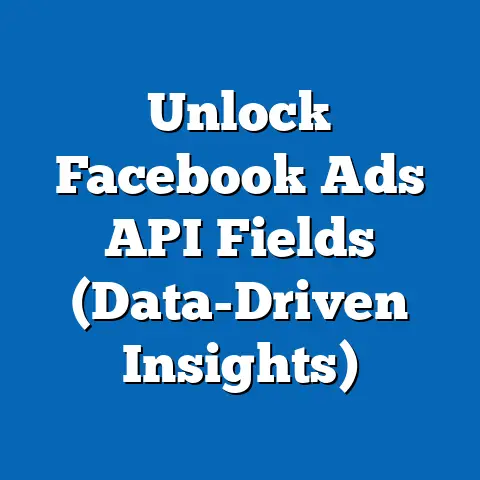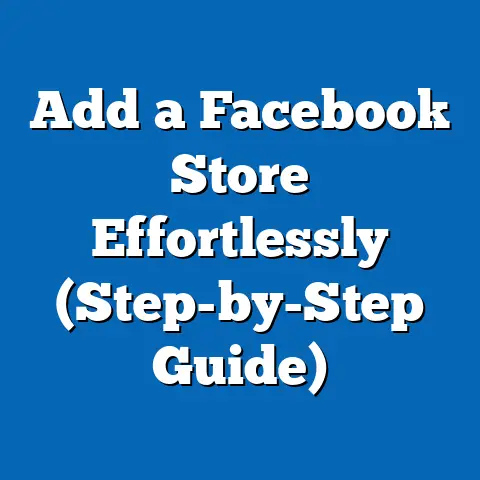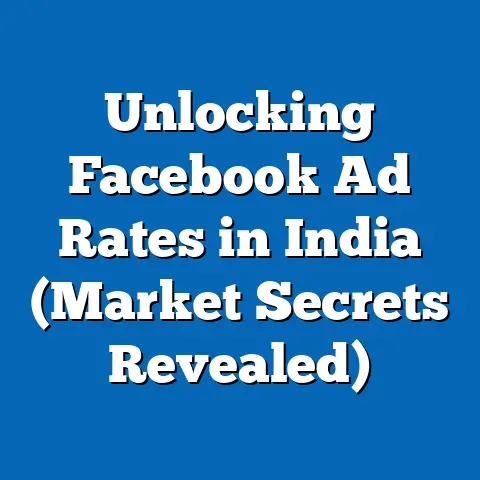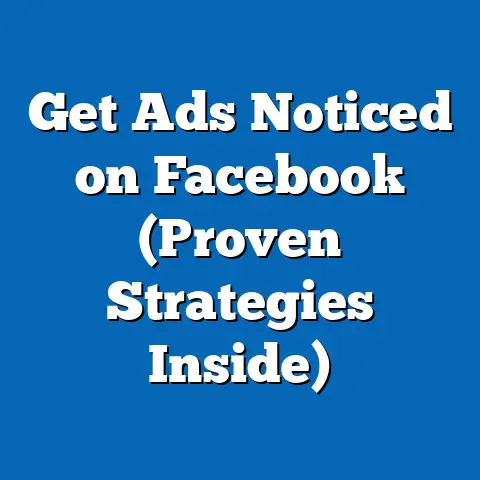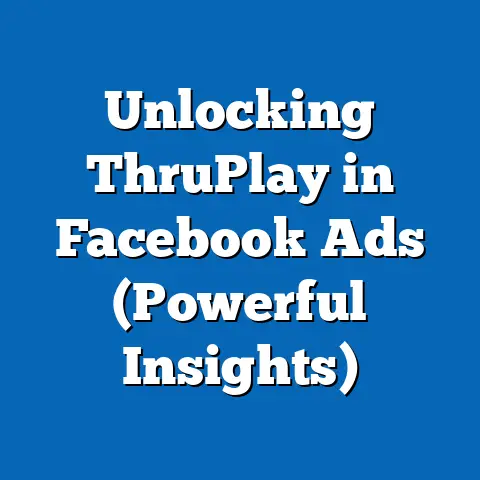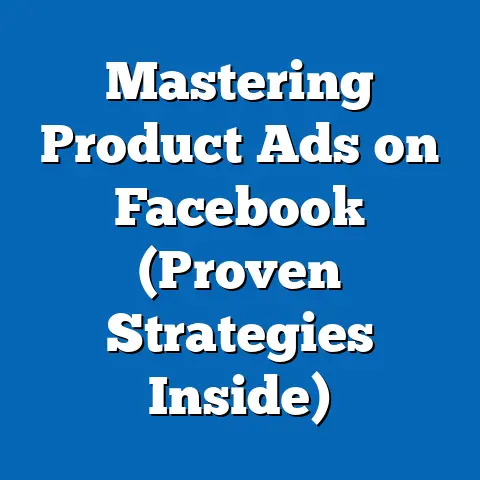Boost fb ad Performance by Changing Users (Expert Strategy)
Facebook advertising. It’s a beast, isn’t it? A constantly evolving landscape where what worked yesterday might be completely ineffective tomorrow. I’ve spent years navigating its twists and turns, and I can tell you one thing for sure: simply throwing money at ads and hoping for the best is a surefire way to drain your budget and see dismal results.
What I’ve learned, through countless campaigns and rigorous testing, is that true success on Facebook hinges on a deeper understanding of your audience and a willingness to strategically shift your approach. It’s about more than just targeting demographics; it’s about understanding the resale value of your customer.
Now, when I say “resale value,” I’m not talking about selling your customers on the black market! I’m referring to the long-term engagement and potential revenue each customer represents. Think of it this way: a customer who makes a single purchase and never returns has a low resale value. A customer who becomes a loyal advocate, making repeat purchases and recommending your brand to others, has a high resale value.
Why does this matter for your Facebook ads? Because by understanding the factors that contribute to a higher resale value – things like customer satisfaction, brand loyalty, and engagement – you can tailor your ads to attract and retain customers who are more likely to contribute to your business’s long-term success.
This isn’t just about getting a quick sale; it’s about building a lasting relationship with your audience. It’s about understanding their needs, addressing their concerns, and ultimately, changing their perception of your brand.
Think about it: If you can convince someone that your product or service is not just a solution to their immediate problem, but also an investment in their future, you’ve significantly increased their lifetime value. That’s where the magic happens. That’s where you see a real return on your ad spend (ROAS) and watch your ad performance soar.
In this article, I’m going to share an expert strategy that goes beyond basic targeting and delves into the psychology of user engagement. I’ll walk you through how to identify your ideal audience, craft compelling ad content, utilize advanced targeting techniques, and, most importantly, measure and analyze your ad performance to ensure you’re constantly improving and maximizing your ROI. This is about strategically shifting your approach to users and altering their perceptions to drive significant results.
So, buckle up, and let’s dive into the world of boosting Facebook ad performance by strategically changing users. It’s time to transform your advertising from a cost center into a profit-generating machine.
Section 1: Understanding Your Audience
Before you even think about crafting ad copy or choosing visuals, you need to have a crystal-clear understanding of your audience. This isn’t just about knowing their age and location; it’s about digging deep into their motivations, desires, and pain points. I’ve seen too many campaigns fail because they targeted the wrong people, or targeted the right people with the wrong message.
Think of it like fishing. You wouldn’t use the same bait for every fish, would you? You need to understand what each species is attracted to, and tailor your approach accordingly. The same goes for Facebook advertising.
Creating Detailed Buyer Personas
The first step in understanding your audience is to create detailed buyer personas. These are fictional representations of your ideal customers, based on research and data about your existing customer base. I like to give my personas names and even find stock photos that represent them. It helps me visualize who I’m talking to.
Here’s what I include in my buyer personas:
- Demographics: Age, gender, location, education level, income, marital status, family size.
- Psychographics: Interests, values, lifestyle, personality, attitudes, opinions.
- Goals: What are they trying to achieve? What are their aspirations?
- Challenges: What are their pain points? What obstacles are they facing?
- Motivations: What drives them to make a purchase? What are their needs and desires?
- Online Behavior: What websites do they visit? What social media platforms do they use? What content do they consume?
- Buying Habits: How do they research products or services? What factors influence their purchasing decisions?
For example, let’s say you’re selling organic baby food. One of your buyer personas might be “Sarah, the Stay-at-Home Mom.”
- Demographics: 32 years old, female, suburban area, college-educated, middle-class income, married, one child.
- Psychographics: Health-conscious, environmentally aware, values natural products, concerned about her child’s well-being.
- Goals: To provide her child with the healthiest and most nutritious food possible.
- Challenges: Finding convenient and affordable organic options, navigating conflicting information about baby nutrition.
- Motivations: Her child’s health and development, a desire to avoid harmful chemicals and additives.
- Online Behavior: Reads parenting blogs, follows health and wellness influencers on Instagram, participates in online parenting communities.
- Buying Habits: Researches products thoroughly, reads reviews, looks for certifications and seals of approval.
By creating this detailed persona, you can start to understand what Sarah is looking for in baby food, what challenges she faces, and what kind of messaging will resonate with her.
Leveraging Facebook Audience Insights
Facebook Audience Insights is a powerful tool that can help you gather data on your target audience. It allows you to explore the demographics, interests, and behaviors of people who are connected to your Facebook page, or who fit certain criteria.
I use Audience Insights to:
- Validate my buyer personas: I can see if my assumptions about my target audience are accurate.
- Discover new interests and behaviors: I can identify new targeting options that I hadn’t considered before.
- Understand the demographics of my existing fans: I can learn more about the people who are already engaged with my brand.
To access Audience Insights, go to Facebook Ads Manager and click on “Audience Insights” in the “Tools” menu. You can then choose to create an audience based on people connected to your page or a custom audience based on demographics, interests, and behaviors.
For example, if I were targeting Sarah, the Stay-at-Home Mom, I might enter interests like “organic baby food,” “natural parenting,” and “health and wellness.” Audience Insights would then show me the demographics, interests, and behaviors of people who are interested in those topics.
I might discover that many of them are also interested in “yoga,” “meditation,” and “essential oils.” This would give me valuable insights into their lifestyle and values, which I could use to tailor my ad messaging.
The Impact of Changing Your Audience
One of the most significant ways to boost your Facebook ad performance is to strategically change your audience. This doesn’t necessarily mean abandoning your existing target market; it means expanding your reach and exploring new segments that might be receptive to your message.
I’ve seen this work wonders in countless campaigns. For instance, I worked with a client who sold high-end dog beds. Initially, they were targeting people who were interested in “dog beds” and “dog accessories.” While they saw some success, their ROAS was relatively low.
After analyzing their customer data, I realized that many of their customers were also interested in “interior design” and “luxury home goods.” I decided to create a new audience segment targeting people who were interested in these topics, and who also owned dogs.
The results were astounding. The new audience segment had a significantly higher ROAS than the original audience. Why? Because these people weren’t just looking for a functional dog bed; they were looking for a stylish piece of furniture that would complement their home decor. By understanding their motivations, we were able to craft ad messaging that resonated with them on a deeper level.
Key Takeaway: Don’t be afraid to experiment with different audience segments. Use Facebook Audience Insights to explore new interests and behaviors, and test different messaging to see what resonates best. Sometimes, the key to boosting your ad performance is simply reaching a different audience.
Next Steps:
- Create detailed buyer personas for your ideal customers.
- Use Facebook Audience Insights to validate your personas and discover new targeting options.
- Experiment with different audience segments to see what drives the best results.
Section 2: The Psychology of User Engagement
Now that you have a solid understanding of your audience, it’s time to delve into the psychology of user engagement. What makes people click on an ad? What makes them take action? Understanding these psychological triggers is crucial for crafting compelling ad content that resonates with your target audience.
I’ve always been fascinated by the way our minds work, and how we can be influenced by subtle cues and messages. In the world of Facebook advertising, these subtle cues can make all the difference between a successful campaign and a complete flop.
Leveraging Psychological Triggers
There are several psychological triggers that can be leveraged in Facebook ads to increase user engagement and drive conversions. Here are a few of the most effective:
- Social Proof: People are more likely to take action if they see that others are doing it. This is why testimonials, reviews, and case studies are so powerful.
- Urgency: Creating a sense of urgency can motivate people to take action quickly. This can be done by highlighting limited-time offers, deadlines, or scarcity.
- Exclusivity: People are often drawn to things that are exclusive or rare. This can be leveraged by offering limited-edition products, exclusive discounts, or VIP access.
- Authority: People tend to trust and respect authority figures. This can be leveraged by featuring endorsements from experts or influencers.
- Reciprocity: People feel obligated to return a favor. This can be leveraged by offering free gifts, valuable content, or personalized recommendations.
Let’s look at some examples of how these triggers can be used in Facebook ads:
- Social Proof: “Join thousands of satisfied customers who are already enjoying the benefits of [your product].” (Include a customer testimonial or review.)
- Urgency: “Limited-time offer: Get 50% off your first month of [your service] if you sign up today!”
- Exclusivity: “VIP access: Be among the first to try our new [product] before it’s released to the public.”
- Authority: “Recommended by [expert]: [Your product] is the #1 choice for [problem].”
- Reciprocity: “Download our free e-book: The Ultimate Guide to [topic].” (Provide valuable content in exchange for their email address.)
The Power of Storytelling
In addition to leveraging psychological triggers, storytelling is a powerful tool for creating an emotional connection with your audience. People are naturally drawn to stories, and they are more likely to remember and engage with ads that tell a compelling narrative.
I’ve seen this firsthand in my own campaigns. Ads that simply list features and benefits tend to be less effective than ads that tell a story about how the product or service has helped someone overcome a challenge or achieve a goal.
For example, instead of saying “Our software helps you manage your projects more efficiently,” you could tell a story about a project manager who was struggling to keep her team on track, and how your software helped her streamline her workflow and meet her deadlines.
The key to effective storytelling is to:
- Identify your target audience’s pain points and desires.
- Create a relatable character who embodies those pain points and desires.
- Tell a story about how your product or service helped that character overcome their challenges and achieve their goals.
- Focus on the emotional impact of the story, rather than just the features and benefits of your product.
Case Studies: Psychological Strategies in Action
Let’s take a look at a few real-world examples of successful Facebook campaigns that have utilized psychological strategies to change user perceptions and behaviors:
- Dollar Shave Club: Their viral video ad used humor and social proof to disrupt the razor industry and convince people to switch to their subscription service.
- Airbnb: Their “Live There” campaign used storytelling and exclusivity to encourage people to experience travel in a more authentic and immersive way.
- Old Spice: Their “The Man Your Man Could Smell Like” campaign used humor and authority to reposition the brand as a cool and desirable option for men.
These campaigns all have one thing in common: they understood their target audience, leveraged psychological triggers, and told compelling stories that resonated with their emotions.
Key Takeaway: Don’t underestimate the power of psychology in Facebook advertising. By understanding what motivates your audience and crafting ads that appeal to their emotions, you can significantly increase user engagement and drive conversions.
Next Steps:
- Identify the psychological triggers that are most relevant to your target audience.
- Craft compelling ad content that leverages those triggers.
- Tell stories that resonate with your audience’s emotions.
- Analyze successful campaigns in your industry and identify the psychological strategies they are using.
Section 3: Crafting Compelling Ad Content
You’ve got your audience dialed in, you understand their motivations, and you’re ready to create some killer ads. But where do you start? Crafting compelling ad content is a delicate art, and it requires a deep understanding of copywriting, visual design, and A/B testing.
I’ve spent countless hours tweaking headlines, testing different images, and experimenting with calls to action. And I can tell you that there’s no magic formula for creating the perfect ad. It’s all about understanding your audience, testing different approaches, and constantly optimizing your content.
The Elements of Effective Ad Copywriting
Your ad copy is the voice of your brand, and it’s what will ultimately convince people to click on your ad and take action. Here are the key elements of effective ad copywriting:
- Headline: This is the first thing people will see, so it needs to be attention-grabbing and relevant. Use strong verbs, ask questions, or make a bold statement.
- Body Text: This is where you explain the benefits of your product or service and address your target audience’s pain points. Keep it concise, clear, and compelling.
- Call-to-Action (CTA): This tells people what you want them to do next. Use strong action verbs like “Shop Now,” “Learn More,” or “Sign Up Today.”
Here are some tips for writing effective ad copy:
- Know your audience: Use language that resonates with them and addresses their specific needs and desires.
- Focus on benefits, not features: Explain how your product or service will improve their lives.
- Use strong verbs and action words: Make your copy dynamic and engaging.
- Keep it concise and easy to read: People have short attention spans, so get to the point quickly.
- Use numbers and statistics: They add credibility and make your claims more believable.
- Test different variations: A/B test your headlines, body text, and CTAs to see what performs best.
The Importance of Visual Elements
Visual elements, including images and videos, play a crucial role in enhancing user engagement. In fact, I’d argue that they’re even more important than the ad copy. People are visual creatures, and they are more likely to notice and engage with ads that have eye-catching visuals.
Here are some tips for using visual elements effectively:
- Use high-quality images and videos: Avoid blurry or pixelated images.
- Choose visuals that are relevant to your target audience: Use images that resonate with their interests and values.
- Use images that evoke emotion: Choose visuals that make people feel something, whether it’s happiness, excitement, or curiosity.
- Use images that feature people: People are drawn to faces, especially those that are smiling or expressing positive emotions.
- Use videos to tell a story: Videos are a great way to showcase your product or service in action and create an emotional connection with your audience.
A/B Testing Your Ads
A/B testing, also known as split testing, is the process of testing different variations of your ads to see what performs best. This is essential for optimizing your ad content and maximizing your ROI.
I A/B test everything, from headlines and body text to images and CTAs. I create multiple versions of my ads, each with a slight variation, and then I run them simultaneously to see which one performs best.
Here’s how to A/B test your ads:
- Identify the element you want to test: Choose one element at a time, such as the headline or the image.
- Create multiple variations of that element: For example, you could create three different headlines.
- Run your ads simultaneously: Make sure each variation gets equal exposure.
- Track your results: Monitor key metrics like click-through rate (CTR), conversion rate, and cost per acquisition (CPA).
- Choose the winning variation: The variation that performs best is the one you should use in your future ads.
- Repeat the process: Continue A/B testing different elements to continuously improve your ad performance.
Altering Messaging to Drive Conversions
One of the most effective ways to shift user perceptions and drive conversions is to alter your messaging to address their specific pain points or desires. This means understanding what your target audience is struggling with and crafting ad copy that offers a solution.
For example, if you’re selling a weight loss program, you could focus on the pain points of being overweight, such as low self-esteem, difficulty exercising, or health problems. You could then position your program as the solution to these problems, highlighting the benefits of losing weight, such as increased energy, improved confidence, and better health.
The key is to:
- Identify your target audience’s pain points and desires.
- Craft ad copy that addresses those pain points and desires.
- Position your product or service as the solution to their problems.
- Focus on the benefits of using your product or service, rather than just the features.
Key Takeaway: Crafting compelling ad content is a continuous process of testing, optimizing, and adapting to your audience’s needs and desires. Don’t be afraid to experiment with different approaches and see what resonates best.
Next Steps:
- Write compelling ad copy that grabs attention, explains the benefits of your product or service, and includes a strong call to action.
- Use high-quality visual elements that are relevant to your target audience and evoke emotion.
- A/B test different variations of your ads to see what performs best.
- Alter your messaging to address your target audience’s specific pain points or desires.
Section 4: Utilizing Advanced Targeting Techniques
You’ve got your audience defined, your psychological triggers identified, and your ad content polished to perfection. Now it’s time to unleash the power of Facebook’s advanced targeting techniques. I’m talking about custom audiences, lookalike audiences, retargeting strategies, and dynamic ads – tools that can take your Facebook advertising to the next level.
I’ve seen firsthand how these techniques can dramatically improve ad performance. By targeting the right people with the right message at the right time, you can significantly increase your ROI and drive more conversions.
Custom Audiences: Targeting Your Existing Customers
Custom audiences allow you to target people who have already interacted with your business, either online or offline. This is incredibly powerful because these people are already familiar with your brand and are more likely to be receptive to your ads.
You can create custom audiences based on:
- Customer List: Upload a list of your existing customers’ email addresses or phone numbers.
- Website Traffic: Target people who have visited your website or specific pages on your website.
- App Activity: Target people who have used your mobile app.
- Engagement: Target people who have interacted with your Facebook page, ads, or videos.
For example, you could create a custom audience of people who have visited your product page but haven’t made a purchase. You could then retarget these people with ads that offer a discount or free shipping to encourage them to complete their purchase.
Lookalike Audiences: Expanding Your Reach
Lookalike audiences allow you to find new people who are similar to your existing customers. This is a great way to expand your reach and target people who are likely to be interested in your products or services.
Facebook uses its vast database of user information to identify the characteristics and behaviors of your existing customers. It then creates a new audience of people who share those same characteristics and behaviors.
You can create lookalike audiences based on:
- Customer List: Upload a list of your existing customers.
- Website Traffic: Target people who are similar to those who have visited your website.
- Facebook Page Fans: Target people who are similar to your Facebook page fans.
For example, if you have a customer list of your top-spending customers, you could create a lookalike audience based on that list. This would allow you to target new people who are likely to be high-value customers.
Retargeting Strategies: Bringing People Back
Retargeting is the process of showing ads to people who have previously interacted with your business but haven’t yet converted. This is a highly effective strategy because these people are already aware of your brand and are further down the sales funnel.
You can retarget people based on:
- Website Visits: Target people who have visited your website or specific pages on your website.
- Facebook Page Engagement: Target people who have interacted with your Facebook page, ads, or videos.
- App Activity: Target people who have used your mobile app.
For example, you could retarget people who have added items to their shopping cart but haven’t completed the checkout process. You could then show them ads that remind them of the items they left behind and offer a discount to encourage them to complete their purchase.
Dynamic Ads and Catalog Sales: Personalizing the Shopping Experience
Dynamic ads allow you to automatically show relevant products to people based on their browsing history and interests. This is a great way to personalize the shopping experience and increase conversions.
You can upload your product catalog to Facebook and then create dynamic ads that showcase your products to people who have shown interest in them. Facebook will automatically select the products that are most relevant to each individual user.
For example, if someone has been browsing your website for shoes, you could show them dynamic ads that feature your latest shoe collection.
Key Takeaway: Advanced targeting techniques can significantly improve your Facebook ad performance by allowing you to reach the right people with the right message at the right time.
Next Steps:
- Create custom audiences based on your existing customers, website traffic, and app activity.
- Create lookalike audiences to expand your reach and target new people who are similar to your existing customers.
- Implement retargeting strategies to bring people back to your website and encourage them to convert.
- Use dynamic ads and catalog sales to personalize the shopping experience for your users.
Section 5: Measuring and Analyzing Ad Performance
You’ve implemented all these strategies, but how do you know if they’re working? Measuring and analyzing your ad performance is crucial for understanding what’s working, what’s not, and how to optimize your campaigns for maximum ROI. I’ve seen too many marketers set up their campaigns and then forget about them, only to be disappointed with the results.
It’s not enough to just launch your ads and hope for the best. You need to be actively monitoring your metrics, analyzing your data, and making informed decisions to adjust your targeting and content.
Key Performance Indicators (KPIs)
There are several key performance indicators (KPIs) that you should be monitoring for your Facebook ad campaigns:
- Click-Through Rate (CTR): The percentage of people who see your ad and click on it. A high CTR indicates that your ad is relevant and engaging.
- Conversion Rate: The percentage of people who click on your ad and then take the desired action, such as making a purchase or signing up for a newsletter. A high conversion rate indicates that your landing page is effective and your offer is compelling.
- Cost Per Acquisition (CPA): The average cost of acquiring a new customer through your Facebook ads. A low CPA indicates that your campaigns are efficient and cost-effective.
- Return on Ad Spend (ROAS): The amount of revenue you generate for every dollar you spend on Facebook ads. A high ROAS indicates that your campaigns are profitable.
- Reach: The number of unique people who saw your ad.
- Impressions: The number of times your ad was displayed.
- Frequency: The average number of times each person saw your ad.
Using Facebook Ads Manager to Track Metrics
Facebook Ads Manager is a powerful tool that allows you to track and analyze your ad performance. You can use it to monitor your KPIs, identify trends, and make informed decisions about how to optimize your campaigns.
To access Facebook Ads Manager, go to https://www.facebook.com/adsmanager/. You can then view your data in a variety of different ways, including:
- Campaign Level: View overall performance metrics for your entire campaign.
- Ad Set Level: View performance metrics for each ad set within your campaign.
- Ad Level: View performance metrics for each individual ad within your ad set.
You can also customize your reports to include the metrics that are most important to you.
Ongoing Optimization: Interpreting Data and Making Informed Decisions
The key to successful Facebook advertising is ongoing optimization. This means continuously monitoring your metrics, analyzing your data, and making informed decisions to adjust your targeting and content.
Here are some tips for ongoing optimization:
- Monitor your KPIs regularly: Check your metrics at least once a day to identify any trends or anomalies.
- Analyze your data to identify what’s working and what’s not: Look for patterns in your data to understand which ads, ad sets, and campaigns are performing best.
- Adjust your targeting and content based on your data: Use your insights to refine your targeting, improve your ad copy, and optimize your visuals.
- A/B test different variations of your ads: Continuously test different elements to see what performs best.
- Stay up-to-date with the latest Facebook advertising trends and best practices: Facebook is constantly evolving, so it’s important to stay informed about the latest changes and updates.
The Role of A/B Testing in Continuous Improvement
As I mentioned earlier, A/B testing is essential for optimizing your ad content. But it’s also crucial for continuous improvement. By constantly testing different variations of your ads, you can identify what resonates best with your audience and make incremental improvements over time.
Don’t just stop testing once you’ve found a winning ad. Continue to test different elements and try new approaches to see if you can improve your performance even further.
Key Takeaway: Measuring and analyzing your ad performance is crucial for understanding what’s working, what’s not, and how to optimize your campaigns for maximum ROI.
Next Steps:
- Identify the key performance indicators (KPIs) that are most important to your business.
- Use Facebook Ads Manager to track your metrics and monitor your ad performance.
- Analyze your data to identify what’s working and what’s not.
- Adjust your targeting and content based on your data.
- Continuously A/B test different variations of your ads.
Conclusion
We’ve covered a lot of ground in this article, from understanding your audience and leveraging psychological triggers to crafting compelling ad content and utilizing advanced targeting techniques. But the most important takeaway is this: boosting Facebook ad performance is not about finding a magic bullet or a secret formula. It’s about understanding your audience, testing different approaches, and continuously optimizing your campaigns.
I’ve shared with you the strategies that have worked for me and my clients, but remember that every business is different. What works for one company may not work for another. The key is to experiment, analyze, and adapt.
Understanding the resale value of your customer and applying the psychology of user engagement is crucial in creating effective Facebook ad campaigns. By focusing on attracting and retaining customers who are more likely to contribute to your business’s long-term success, you can significantly increase your ROI and drive more conversions.
So, I encourage you to implement the strategies discussed in this article and continuously adapt your approaches for optimal results. Don’t be afraid to experiment, to challenge your assumptions, and to learn from your mistakes.
The world of Facebook advertising is constantly changing, but one thing remains constant: the importance of understanding your audience and providing them with value. If you can do that, you’ll be well on your way to boosting your Facebook ad performance and achieving your business goals.
Now, go out there and create some amazing ads! I’m confident that with the strategies and insights I’ve shared with you, you’ll be able to transform your Facebook advertising from a cost center into a profit-generating machine. Good luck!

